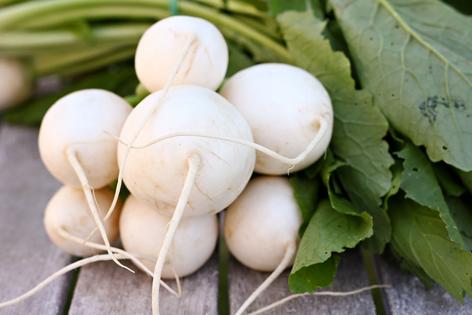Environmental Nutrition: Turn up for turnips!
Today's turnips are all the rage in farm to table restaurants and are enjoyed for their subtly sweet flavor and nutrient density.
The folklore
Despite a history as peasant food in ancient times, and later a reputation as the source of dinnertime revolt for many children, this bulbous root deserves a say -- it has plenty to bring to the table! In fact, Roman philosopher Pliny the Elder wrote that the turnip was one of the most important vegetables of his day. Not only was it used as farm animal fodder, but it could be left in the ground (or later, the cellar) until the next harvest, a safeguard against human famine. Ancient Greeks and Romans believed turnips had healing powers -- they made a syrup from turnips to cure whooping cough and the common cold.
The facts
The turnip (Brassica rapa) is a cruciferous root vegetable in the mustard family, along with cauliflower, cabbage and Brussels sprouts. There are over 30 varieties of turnips, which differ in size, taste and use, including small "baby" specialty turnips. Topped by edible greens (similar to mustard greens), the spherical root averages three inches diameter, is white below the earth with a kiss of purple, red, or green where exposed to the sun, and tapers into a thin taproot. A 1-cup serving has only 34 calories, yet packs 12 percent DV (Daily Value, based on 2,000 calories/day) of dietary fiber, 30 percent DV of vitamin C, and plenty of powerful health promoting phytonutrients.
The findings
One such compound in cruciferous vegetables, like turnips, is brassinin, which has been shown in lab studies to kill colon cancer cells (International Journal of Oncology, 2012). Among cruciferous vegetables, turnip sprouts were shown to have among the highest concentrations of glucosinolates, a compound known for its anti-cancer activity (Journal of Agricultural and Food Chemistry, 2012). In addition, eating high fiber foods, such as turnips, is associated with lower colorectal cancer death (JAMA Oncology, 2018). Lastly, a study published in the Journal of Epidemiology suggests higher dietary intakes of antioxidant vitamins, like the vitamin C in turnips, may reduce risk of death from any cause in middle aged Japanese women.
The finer points
Turnips are available all year, but they're best eaten when they're young, small, tender and sweet. Choose smooth, firm bulbs that are heavy for their size, and if greens are attached, be sure they're bright and fresh. Refrigerate bulbs, wrapped in plastic, for up to two weeks. Remove skin, greens and taproot before slicing or grating small bulbs raw into salads and slaws for added zing and crunch, or slicing or cubing them to boil, saute, bake or steam. Try turnips mashed or added to soups, layered into a comforting gratin, or combined with carrots, parsnips, sweet potatoes and hearty squash in a colorful veggie roast.
...continued







